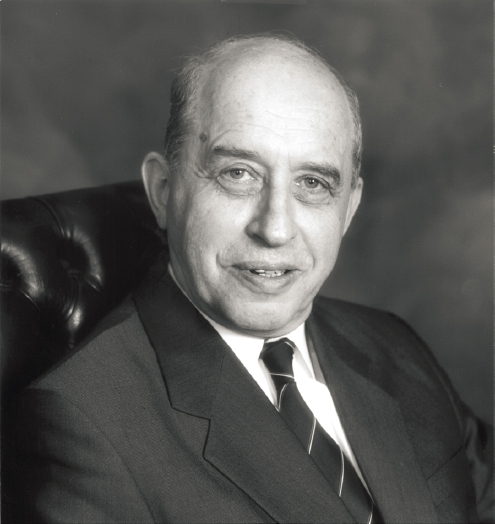

GRIGORY I. BARENBLATT
1927–2018
Elected in 1992
“For major contributions to understanding flow of fluids through fractured porous media that have aided production of gas and oil worldwide.”
BY EMMANUEL DETOURNAY, CHRISTINE EHLIG-ECONOMIDES, AND YANNIS C. YORTSOS
GRIGORY ISAAKOVICH BARENBLATT died in Moscow on June 22, 2018, at the age of 90.
He was born in Moscow on July 10, 1927, to parents who were accomplished in medicine. His mother, Nadezhda Veniaminovna Kagan, was a virologist who developed a vaccine against viral encephalitis (unfortunately, she contracted and died from the disease); his father, Isaak Grigorievich Barenblatt, was an endocrinologist.
Grigory graduated in 1950 from Lomonosov Moscow State University (MGU), Faculty of Mechanics and Mathematics, and in 1953 successfully defended his PhD thesis, under the guidance of Andrei N. Kolmogorov—one of the most influential mathematicians of the last century—and his DSc thesis in 1957. He became a professor at MGU and then head of the Plasticity Department of the Institute of Mechanics (1961–75).
Over the decades Barenblatt held a number of positions at the USSR Academy of Sciences. He worked at the academy’s Institute of Petroleum (1953–61). He took part in the creation and was deputy director of the Institute of Problems in Mechanics (1965). He later served as head of the Theoretical Department at the Institute of Oceanology (1975–92).
___________________
The authors drew on the obituary for G.I. Barenblatt published in the European Mathematical Society Newsletter 2018-9(109):33–38.
Many of us knew him for his beautiful work on self-similarity, particularly in flows in fractured and porous media, and on intermediate asymptotics, a domain he founded following his PhD work. His partnership with another mathematician of note, Yakov Zeldovich, led to the discovery of the relationship between similarity and asymptotics, and its applications to fluid flow in porous media, among other areas. (Interestingly, Barenblatt was also the son-in-law of Pelageia Yakovlevna Polubarinova-Kochina, another giant of applied mathematics, who contributed significantly to understanding of flow in porous media.)
Barenblatt contributed pioneering work in flow in fractured media, including the classic text on naturally fractured reservoir characterization (introduced in Western literature by Warren and Root, 1963). That work became the standard for conceptual models used both for pressure transient analysis and for numerical simulation models. He also provided key insights in the modeling of cracks in brittle media, hydraulic fracture, flow of groundwater, nonequilibrium two-phase flow in porous media (capillary imbibition, water-oil displacement, and solid phase precipitation), and the mathematical modeling of gas-condensate flow in fractured porous media. In parallel, he developed a large body of work on turbulent flows, nonlinear waves, intermediate asymptotics, the stability of self-similar solutions and traveling waves, and the theory of combustion.
With the fall of the Soviet Union, Barenblatt traveled overseas, as did many of his contemporaries and colleagues, including another notable mathematician with interests in subsurface fluid flow, the late Vladimir Entov, whom one of us (YCY) hosted in 1991. Together with Entov and V.M. Ryzhik, Barenblatt coauthored the monograph The Motion of Fluids and Gases in Natural Rocks (in English) (Kluwer, 1990).
But to us, his most original and insightful book was Scaling, Self-Similarity, and Intermediate Asymptotics (foreword by Y.B. Zeldovich) (in English; Plenum Press, 1979; Cambridge University Press, 1996). It opened up a new (and beautiful) way to view the development of similarity solutions in a number of nonlinear partial differential equations.
He became the G.I. Taylor Professor of Fluid Mechanics at the University of Cambridge in 1992 (and subsequently held the title emeritus). Over several years he did stints as a visiting professor at the University of Rome Tor Vergata (1992), Universidad Autónoma de Madrid (1993, 1996), and University of Minnesota (1994).
In 1996 he joined the University of California, Berkeley, as a visiting professor, later becoming professor in residence; he held a concurrent position at the Lawrence Berkeley National Laboratory (LBL). It is at UC Berkeley that one of us (YCY) met him at an LBL seminar on February 10, 1999, on flow and displacement in fractured rock, organized in honor of the 80th birthday of another giant in the field, the late Paul Witherspoon. Grigory’s enthusiasm on the subject and his immense curiosity about other people’s approaches were contagious. His communications often inquired about different approaches and methods in a variety of problems in porous media.
In addition to his election as a foreign member of the NAE, Barenblatt was an international member of the US National Academy of Sciences, American Academy of Arts and Sciences, and Royal Society of London, as well as scientific societies in other countries. Among his many awards are the Lagrange Prize of the Accademia Nazionale dei Lincei (1995), G.I. Taylor Medal of the US Society of Engineering Science (1999), J.C. Maxwell Medal and Prize of the International Congress for Industrial and Applied Mathematics (1999), and Timoshenko Medal of the American Society of Mechanical Engineers (2005).
He returned to Moscow in his last years and is survived by daughters Nadezhda Kochina and Vera Kochina.




